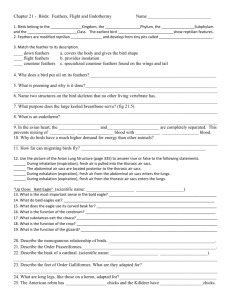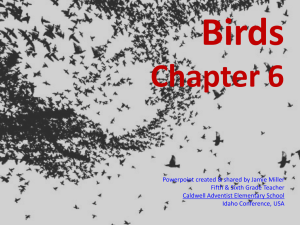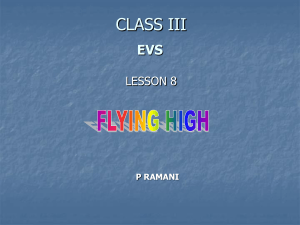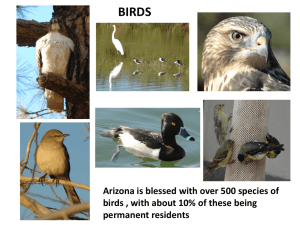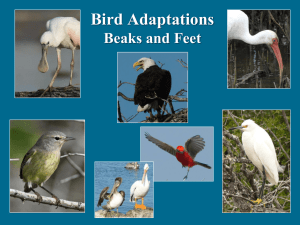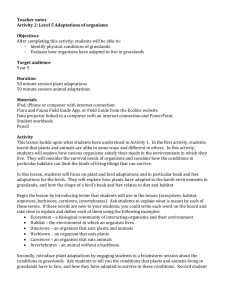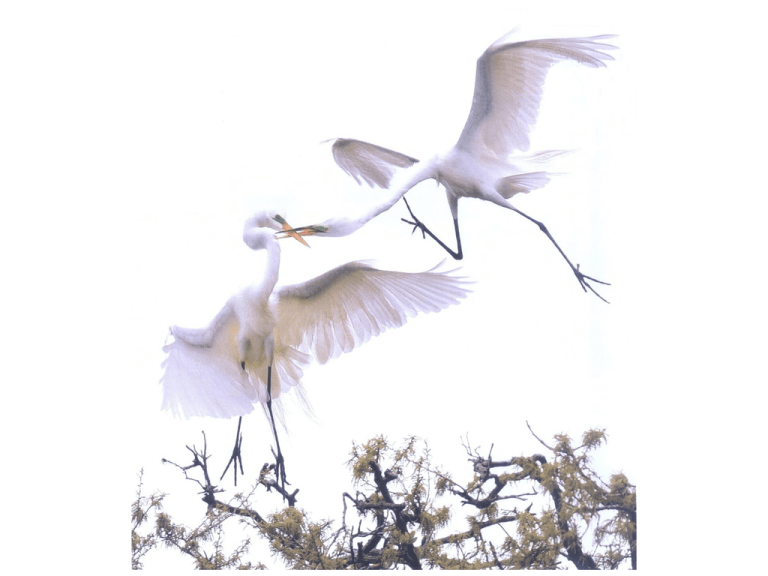
Ornithology: Introduction
A little over 9,700 bird species live in
the world today.
The diversity of life is very large. Planet Earth is home to
an incredible variety of animal life.
There are about 4,600 mammal species
(one of which is humans),
about 9,700 bird species,
about 8,000 reptile species,
about 4,700 amphibian species,
and 25,000 different kinds of fish.
Insect species are estimated to be about 10 million species.
The world's smallest bird is the Bee
Hummingbird found only in Cuba.
1.8 grams (penny=2.5g) 5cm
(Light Direction and Angle of View
produces perception of different colors)
The world's largest bird is the Ostrich
Ostriches
usually weigh
from 90 to 130
kg
(200 to 285
pounds),
and are 1.8 m
to 2.7 m
(6 feet to 9
feet) in height
Characteristics and Adaptations
The defining characteristic of birds
is the presence of feathers. All birds
have feathers and having feathers
(today) is completely unique to
birds.
Feathers, e.g., for display
Feathers, e.g., for display
Feathers, e.g., for display
Birds of Paradise
http://www.cornell.edu/video/?VideoID=2398
Feathers, e.g., for display
sound!
Common Nighthawk
http://www.allaboutbirds.org/guide/Common_Nighthawk/videos
Club-winged Manakin
http://news.nationalgeographic.com/news/2009/11/091111-birds-sing-feathers-wings.html
Feathers, e.g., for flight
Falcon
Beaks
http://www.youtube.com/watch?v=XzHQ5-lYvrk&NR=1
Beaks
Beaks
Beaks
Lesser Nighthawk
Hummingbird
Not all animals that have beaks are birds
Hawksbill Sea Turtle
Not all animals that have beaks are birds
Giant Humbolt Squid
Beak
Octopus dofleini
Beak
Adaptations for Flight
Adaptations for Flight
e.g., efficient uptake of oxygen –
compare to Humans:
21% oxygen in and
% out
Adaptations for Flight
e.g., efficient uptake of oxygen –
compare to Humans:
21% oxygen in and 16% out
Birds: Peter Ward found that at sea
level birds breathe 30 percent more
efficiently than mammals and at
5,000 feet in elevation birds are 200
percent more efficient.
Leg bone length modified for
balance, e.g., to incubate eggs.
Adaptation for perching.
Adaptations for Different Modes
of Life
Variation Within
each Order of
Birds
(e.g., Shorebirds,
gulls, allies
Charadriiformes)
Bill Lengths Vary
Adaptations and Variations within
the context of evolution.
Handout:
Darwin’s Theory of Evolution
and
Theory of Natural Selection
Adaptation – any inherited
characteristic that helps an
organism to survive and reproduce.
Coevolution – the evolution of two
species living together such that
they influence each other’s
adaptations.
Adaptation - Coevolution
Erythrina crista-galli (crybabytree)
– The anthers are positioned to
dust the top of the hummingbird
as it drinks.
Theory of Sexual Selection
If one sex has it and the other
sex likes it, sexual selection can lead
to any ARBITRARY trait, as long as it
doesn’t impair survival too much.
Long-tailed
Widowbird
of
South Africa
Long-tailed Widowbird
of South Africa
Variation allows
and reflects
Niche Partitioning,
e.g., in Hawaiian
Honeycreepers
Extreme example
in wing adaptation
Species Niche
A species niche consists of the
combination of:
1. the physical space (habitat)
occupied by individuals of that
species,
2. the functional role (“life style”)
that species has in the community
3. the physical, environmental
requirements of the species.
Variation in feet reflect different
niches (lifestyles)
Niche Partitioning
of the Environment
1. If two species live in the same
place, then they feed differently or
on different foods.
Woodpecker
Nuthatch
Niche Partitioning
of the Environment
1. If two species live in the same
place, then they feed differently or
on different foods.
2. If two species feed similarly, then
they live in different places.
3. Each species has structural
modifications to adapt to its niche.
4. Niche partitioning of the
environment allows coexistence
of different species in the same
general area.
5. The competitive exclusion
principle states that niches of
different species in the same area
do not overlap.






